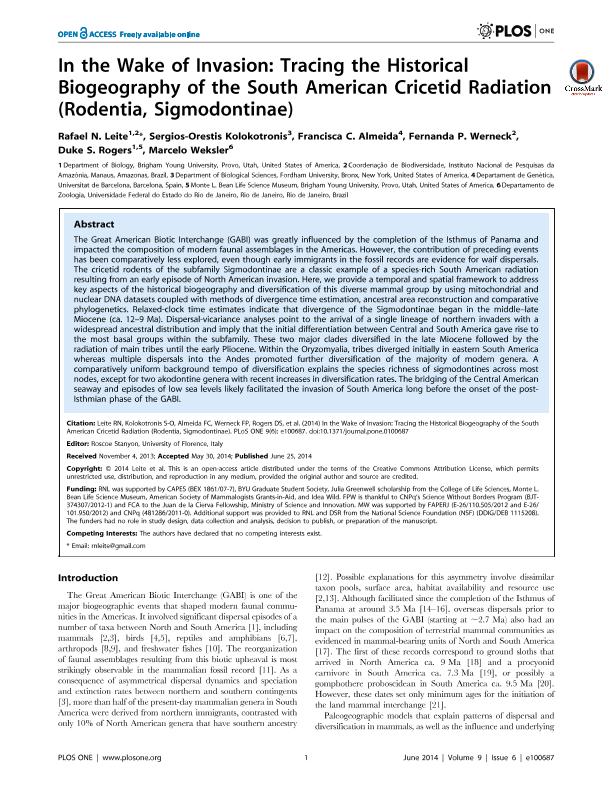Artículo
In the wake of invasion: Tracing the historical biogeography of the South American cricetid radiation (Rodentia, Sigmodontinae)
Leite, Rafael N.; Kolokotronis, Sergios Orestis; Cunha Almeida, Francisca ; Werneck, Fernanda P.; Rogers, Duke S.; Weksler, Marcelo
; Werneck, Fernanda P.; Rogers, Duke S.; Weksler, Marcelo
 ; Werneck, Fernanda P.; Rogers, Duke S.; Weksler, Marcelo
; Werneck, Fernanda P.; Rogers, Duke S.; Weksler, Marcelo
Fecha de publicación:
06/2014
Editorial:
Public Library of Science
Revista:
Plos One
e-ISSN:
1932-6203
Idioma:
Inglés
Tipo de recurso:
Artículo publicado
Clasificación temática:
Resumen
The Great American Biotic Interchange (GABI) was greatly influenced by the completion of the Isthmus of Panama and impacted the composition of modern faunal assemblages in the Americas. However, the contribution of preceding events has been comparatively less explored, even though early immigrants in the fossil records are evidence for waif dispersals. The cricetid rodents of the subfamily Sigmodontinae are a classic example of a species-rich South American radiation resulting from an early episode of North American invasion. Here, we provide a temporal and spatial framework to address key aspects of the historical biogeography and diversification of this diverse mammal group by using mitochondrial and nuclear DNA datasets coupled with methods of divergence time estimation, ancestral area reconstruction and comparative phylogenetics. Relaxed-clock time estimates indicate that divergence of the Sigmodontinae began in the middle-late Miocene (ca. 12-9 Ma). Dispersal-vicariance analyses point to the arrival of a single lineage of northern invaders with a widespread ancestral distribution and imply that the initial differentiation between Central and South America gave rise to the most basal groups within the subfamily. These two major clades diversified in the late Miocene followed by the radiation of main tribes until the early Pliocene. Within the Oryzomyalia, tribes diverged initially in eastern South America whereas multiple dispersals into the Andes promoted further diversification of the majority of modern genera. A comparatively uniform background tempo of diversification explains the species richness of sigmodontines across most nodes, except for two akodontine genera with recent increases in diversification rates. The bridging of the Central American seaway and episodes of low sea levels likely facilitated the invasion of South America long before the onset of the post-Isthmian phase of the GABI.
Palabras clave:
Sigmodontinae
,
Great Biotic Interchange
,
Radiation
,
Molecular Phylogeny
Archivos asociados
Licencia
Identificadores
Colecciones
Articulos(IEGEBA)
Articulos de INSTITUTO DE ECOLOGIA, GENETICA Y EVOLUCION DE BS. AS
Articulos de INSTITUTO DE ECOLOGIA, GENETICA Y EVOLUCION DE BS. AS
Citación
Leite, Rafael N.; Kolokotronis, Sergios Orestis; Cunha Almeida, Francisca; Werneck, Fernanda P.; Rogers, Duke S.; et al.; In the wake of invasion: Tracing the historical biogeography of the South American cricetid radiation (Rodentia, Sigmodontinae); Public Library of Science; Plos One; 9; 6; 6-2014; 1-12; e100687
Compartir
Altmétricas



